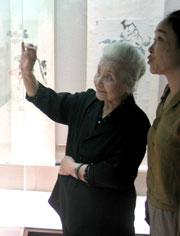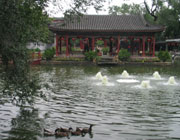A wander through Beijing's remaining hutongs often leads to a large wooden
gate with golden door knockers.

Two visitors appreciate paintings yesterday by
renowned artist Pu Ru(1986-1963), who was also known as Pu Xinyu. [China
Daily] |
Behind these doors lay secrets from a
century past and it is little known that within a colourful period of Chinese
history it lightens up the surrounding small grey gates of the more typical
siheyuan courtyards.
Behind the doors may lie a palace that once belonged to the young princes or
princesses of the ruling dynasty more than a century ago.
"Such a palace is called 'wangfu' in Chinese. They are something between the
Forbidden City and the siheyuan courtyards, and bears features of both," says
Shi Shuqing, a researcher with the National Museum of China.
At the prime of the Qing Dynasty (1644-1911), there were more than 50 such
palaces in downtown Beijing. Less than half remain because of the rampant
demolishing and reconstruction. Of the 22 still standing, only eight remain in
what researchers describe as a preserved state.
These are scattered in hutongs in the small area around Shichahai and Beihai
lakes, two of the capital's nightlife centres. Though an occasional visit to
most of them is available once permission has been granted, only two have been
officially partly opened to the public.
The country's first museum on these royal palaces called the Museum of Great
Chinese Royal Palaces is currently being built inside the Palace of Prince Gong,
and is due to be open before the 2008 Olympics in Beijing. The gardens of the
Palace of Prince Gong were opened to the public 16 years ago.

The garden of the Palace of Prince Gong, which
opened to the public 16 years ago [China
Daily] |
The palace, covering 61,000 square
metres, is tucked away in the Liuyinjie hutong beside the Sichahai Lake. Known
as Gongwangfu in Chinese, it is believed to be one of the largest and best
preserved among Beijing's wangfus.
"It's of great urgency that we preserve what we have left of the delicate
palaces. Damage to them has been going on for a century," says Kong Xiangxing,
director of the consultative committee of the new museum, who was vice-director
of the National Museum of China before taking up his new post.
The remaining palaces were all built in the Qing Dynasty. During the Ming
Dynasty (1368-1644), wangfus were built in the Wangfujing area, but nothing
remains of them.
The famous Wangfujing Street, which is today the capital's main shopping
centre, was named after the 10 palaces of princes and princesses built in the
area.
"When the royal power fell before democratic revolutions, princes and
princesses, who had to sell their properties to make ends meet, moved out one
after another in the early half of the 20th century," explains researcher Shi.
"Members of the new upper class at that time, including officials of new
governments, businessmen and some foreigners, moved in and every new owner
pulled down something old and added something new to their liking," he adds.
Hotels, apartment and office buildings now stand where the old wooden palaces
once stood.
Of the 22 existing palaces, four have only broken walls and several
dilapidated houses, including palaces of Prince Yi, Ding, Heng and Tui along the
Ping'an Avenue.
Seven still have the general look of a palace, with the palace gates or a few
major buildings left.
"Memories of the palaces are diminishing fast and documents of them are rare
as the Qing official files rarely mentioned the wangfus. We need help from the
public and from the international art community to find relative documents and
relics," says director Kong.
Seeking relics
The ambitious plan of the new museum includes a document and a research
centre plus collections and displays of the art and histories of the palaces,
and of those who lived in them.
Kong said they hope to collect documents and photos of the palaces,
furniture, ceramics, jade artifacts, the statues of Buddha, clocks and
stationeries that once adorned the rooms. Clothes, calligraphies and paintings
worn and drawn by the princes and princesses who once owned the palaces are also
being sought.
"We have lost track of most relics of the Palace of Prince Gong," says Lu
Ning, director of the relic administration centre of the palace.
"We only know that a famous painting by 8th-century Chinese artist Han Gan,
titled 'Picture of a horse named Zhaoyebai' (Zhaoyebai Tu), was sold by the
prince's descendants to the Metropolitan Museum of Art in New York in 1936, and
a quantity of sandalwood furniture is collected by the Taipei Palace Museum.
It's apparently too difficult to get them back at present," he adds.
Lu says the new museum is negotiating with the Jietai Temple in suburban
Beijing to recover furniture used in the palace which is in the latter's
collection.
The palaces were treasure houses of art as the princes and princesses, who
had money and time to spare, were enthusiastic art collectors, said director
Kong.
"Important calligraphies and paintings were hung around the palace, which has
about 100 rooms," says Lu.
A palace, the size of which varied according to the rank of its owner, was
built in the basic layout of the Forbidden City.
"The difference of an emperor's palace and a prince's lies mainly in the
number, height and sizes of buildings in the palace," explains researcher Shi.
Roofs on the palace could only be covered with green glazed tiles, while
golden glazed tiles shine in the Forbidden City.
Patterns of the dragon head were not allowed on a prince's palace.
"A prince's palace is actually a combination of siheyuan courtyards, with one
lying behind another. That's also the layout of the Forbidden City," says Shi.
Some of the palaces had gardens built in the style of the royal garden in the
Forbidden City, combining the magnificence of northern China and the grace of
Suzhou gardens in East China's Jiangsu Province.
"When the era of princes and princesses came to an end, the owners usually
sold up or simply lost their treasures, including art collections, then gardens,
and finally their houses," says Shi.
"We only have a few of such palaces left and it's impossible to rebuild such
beautiful old architecture. Once it is damaged and lost, it will be lost
forever," he warns.